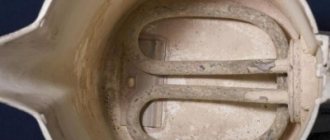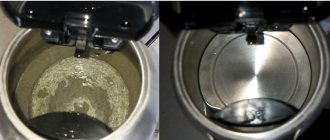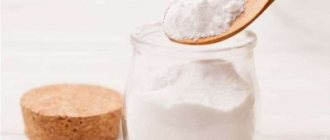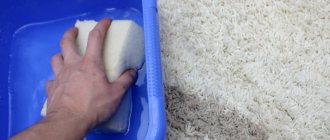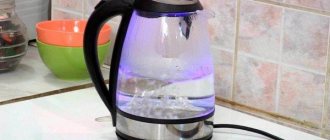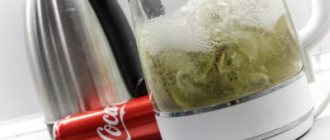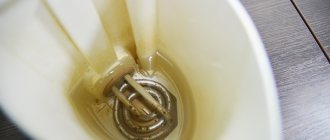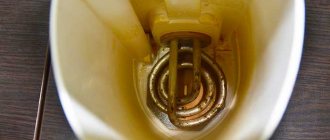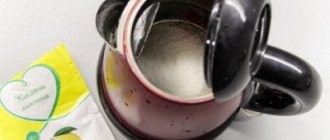Many problems arise for housewives due to hard water, and one of them is the appearance of scale in the kettle. Lime deposits on the walls and bottom worsen the taste of the drink, spoil the body material, and shorten the service life of the dishes. And the appearance of surfaces (especially inside) becomes unattractive - with layers, brown and whitish spots.
To remove them, various methods and means are used, buying ready-made household chemicals or making solutions yourself. It’s easy to remove scale with vinegar, especially since this product can be found in any kitchen. The main thing is not to forget about compliance with certain rules, safety and proportions.
Why vinegar works well against scale
Limescale deposits appear inside due to the use of tap water. It contains hardness salts (most often magnesium and calcium), which, when heated, are converted into a sediment in the form of flakes, as well as layers on the walls. The longer they boil water in a container, forgetting about regular cleaning, the thicker the deposits.
Acid-containing compounds will help remove a thick layer of lime. In the case of vinegar, it is a monobasic carboxylic acid, which, when interacting with solid deposits, softens the salts and turns them into dust.
The pure composition is a 100% acid solution, but in everyday life they use essence and table vinegar. The first is a concentrated (30-80 percent) acid solution, and therefore requires care and precision when used.
Table vinegar usually contains 3, 6 or 9% acid (indicated on the label), it is not as dangerous as essence, but it will also take more time to clean when using it.
The higher the concentration, the more effective the cleaning at home, but you need to take into account possible damage to the material of the kettle body (see video).
Features for different types of kettles
Metal, glass and plastic teapots are not afraid of contact with vinegar. However, there are certain cleaning rules that should not be violated:
Essence cannot be used to remove lime deposits from a plastic kettle. It contains too high a concentration of acid, so its incorrect use can cause damage to the device.- To remove scale from glass teapots, do not use hard metal brushes. They leave behind many small scratches, on which calcium salts will subsequently settle.
- Stainless steel teapots are not afraid of contact with acids; their inner surface can be cleaned with a stiff brush, but in no case should you use sharp devices, such as a knife.
- To clean electrical appliances, it is unacceptable to use a combination of baking soda and vinegar. This recipe is only suitable for descaling regular kettles.
- It is not recommended to treat enamel teapots with vinegar, as they are susceptible to acid attack. If you have such a device in your home, it is better to use a colorless carbonated drink.
Recipes for boiling
Having chosen a suitable method for yourself, anyone can clean a kettle using vinegar. The thickness of the deposits is taken into account (old thick layers of scale require more time) and the material from which the body of the cookware is made.
When boiling, the layers soften better and faster, the procedure requires less time.
Clean the kettle with 9% vinegar
Small deposits can be easily boiled using a low concentration product (9%). For example, apple cider vinegar is poured into a bowl of water, brought to a boil, then left for 20-30 minutes. If the scale is old, then the holding time after boiling is increased to several hours (for example, from evening to morning).
Step by step steps:
- Pour clean cold water into the kettle;
- add 9% table vinegar. Use 2 tbsp per liter of water. l. composition;
- put the kettle on the stove;
- boil, keep on fire for 8-10 minutes;
- cool down.
After waiting 2-3 minutes after the water first boils, the electric kettle is turned on again so that the solution boils again. After this, it is left to soften the layers.
Lime layers are loosened and easily and quickly separated from the walls and bottom of the dish. They are removed with a sponge, and the kettle is rinsed with clean water 2-3 times.
Preparing the composition with vinegar essence
A highly concentrated product is used in difficult cases when hardness salts gradually crystallize, turning into a solid coating. Old layers give the walls and bottom of the kettle a resemblance to karst caves. When boiling, flakes form and the water acquires an unpleasant aftertaste.
What they do:
- fill the kettle with cold water;
- carefully add the essence (70%) in the following proportions - take 1 tablespoon of the product per liter of water;
- boil;
- remove from heat (if the kettle is intended for the stove) or unplug and leave for 10-12 hours.
During this time, the layers of scale soften and can be easily removed with a cloth or sponge. Further actions are as in the previous recipe: rinse the container well (2-3 times) until the sharp vinegar smell completely disappears.
Good results are obtained by a combined composition where vinegar essence is mixed with ascorbic acid.
The recipe is simple:
- the kettle is filled approximately 2/3 with water;
- add a spoonful of essence;
- add two tablespoons of ascorbic acid (powder);
- boil.
Leave the solution in the kettle for 10-12 hours to soften the scale. Remove plaque with a sponge and rinse the dishes with running water.
The essence is used for three-stage cleaning, when old plaque is removed from the walls.
Actions:
- fill the kettle 2/3 with water, pour in soda (take a tablespoon of the product per liter);
- boil, set aside for about 40-50 minutes;
- the solution is replaced with fresh water and citric acid is added (a tablespoon of powder per 1 liter), boiled, removed from the heat and kept for 40-50 minutes;
- pour the solution again, collect clean water, add essence (10 ml per 1 liter), boil, leave for an hour;
- drain the solution and rinse the kettle several times.
This procedure takes time, but the result usually pleases housewives. The walls and bottom of the dishes are cleaned of plaque and regain their original appearance.
It’s not worth bringing the kettle to this state; after all, three-step cleaning is an extreme measure. It is advisable to clean dishes regularly using special or improvised products.
Soda with vinegar
Thanks to this composition, dense layers of lime loosen and fall behind the walls. It’s easy to remove scale with vinegar and soda, but you must maintain the proportions of the solution.
What they do:
- the kettle is filled with clean water (2/3);
- add a couple of tablespoons of soda (the amount is indicated for 1.5 liters), half a tablespoon of vinegar (take 9%);
- mix gently;
- bring to a boil;
- remove from heat and leave for half an hour.
The scale is removed with a sponge, the kettle is thoroughly washed. For heavy deposits of plaque and fat, use soda ash.
Why descale your kettle?
Scale is a powder that settles on the bottom of the kettle and a whitish crust on its walls. Formed after boiling hard water.
Attention! An electric kettle with a plastic body cannot be cleaned with chemicals.
A layer of scale in a regular kettle degrades the quality of water and slows down the boiling process.
If you do not descale your electric kettle:
- The household appliance begins to work longer. Consequently, more electricity is consumed.
- In a kettle with a plastic body, the seals between the base and the plastic flask are destroyed. In advanced cases, this leads to leakage. This device cannot be used.
- It will quickly fail.
How long to boil
Numerous recommendations on how to descale a kettle with vinegar mention different boiling times. It depends on the concentration of the product used and the thickness of the layers.
Usually, 10-15 minutes of boiling (for metal, enamel models) on the stove is enough, after which the kettle is removed from the heat. It is more difficult with electrical appliances, since modern kettles are usually equipped with automatic devices.
In this case, after switching off, wait 2-3 minutes and start the device again. Repeat this 2-3 times, and then wait until the solution cools completely.
How often should cleaning be done?
The kettle should be cleaned at least once a month. If tap water is hard, then the procedure is carried out once every 2 weeks. Thanks to this frequency, you can keep the device clean, which will have a positive effect on its service life.
There are regions where tap water is soft. In this case, cleaning the kettle with vinegar is carried out once a month.
Even if you need to deal with scale more frequently, there is no need to worry about it. Vinegar does not harm the walls of the device and does not reduce its service life.
Descaling without boiling
When the vinegar solution is heated, caustic vapors of the product are released into the air. There is a strong smell in the room that not everyone likes. Therefore, many housewives try to do without boiling, pouring essence or table vinegar into already heated water.
Sequencing:
- pour clean water (2/3 of the volume);
- boil;
- pour in a tablespoon of essence (70%) and leave for several hours.
Afterwards, clean the inner walls and bottom of the dish from deposits, rinse the container 2-3 times until the smell disappears. The method is simple, but is only suitable for small dirt and a thin layer of scale. Old layers cannot be cleaned this way.
How to clean a kettle with cola
You can clean a glass electric kettle with Sprite drink, as Cola turns glassware yellow. Open the plastic bottle with Sprite to release the gas, add water. Boil the mixture in a kettle for 15 minutes, then drain and rinse the inside with a kitchen sponge.
Cleaning the kettle with folk remedies
Have you ever cleaned your kettle with cola?
Not really
How to remove vinegar smell
One of the most effective products for descaling dishes has one problem - a pungent odor that lingers in the kettle for a long time. To eliminate the specific aroma, it is recommended to boil the dishes with salt or soda after cleaning.
Here's a life hack: pour water, add your choice of a spoon (tablespoon) of salt or the same amount of baking soda. Boil and, after standing for 10-15 minutes, drain the solution.
A good result after cleaning is obtained by boiling water with a pinch of citric acid (can be replaced with a slice of natural citrus).
Is it possible to prevent scale formation?
Even when buying “Lux” water, you cannot completely forget about scale in the kettle.
To reduce this problem, the following conditions are recommended:
- Use filters when water comes from the central system. Manufacturers offer different installations. They are small in size and can be placed under the sink. Replacing inexpensive cassettes will not hit the family budget. A filter installed directly on the tap is economical and effective.
- Drain off the remaining boiled water. Otherwise, salts will continue to be deposited and the plaque layer will increase.
- Use fresh water each time you boil.
- Keep a separate soft sponge in the kitchen for daily cleaning of the kettle. Do this procedure at night.
- Change the removable block in the filter jug in a timely manner.
Advantages and disadvantages
The main “advantage” of vinegar is its availability and low cost. Manufacturers of household chemicals offer many different compositions for cleaning kitchen utensils from limescale, but almost all of them are expensive, and some are also ineffective. Vinegar is sold in any grocery store, and solutions of different concentrations are available to customers.
Advantages and disadvantages
Safety.
Efficiency.
Easy to use.
Economical.
When solutions are heated, caustic vapors are formed. They are safe for human health, but it is better to work in a ventilated area.
Not suitable for all models.
Heavy scale will need to be removed step by step and only with boiling.
The main thing is not to bring the dishes to a terrible state and the formation of old layers of deposits, when radical cleaning is required.
How to get rid of limescale in an electric kettle?
An electric kettle can also be cleaned of limescale using vinegar. But since vinegar is a rather caustic substance, it would be better to use citric acid. This cleaning will take very little time. Pour water into the kettle, dissolve one sachet of citric acid and boil for 5 - 7 minutes. To prevent the kettle from automatically turning off during boiling, the lid must be raised. After this procedure, you need to evaluate the result obtained - if there are still traces of limescale on the walls, the steps can be repeated. If all the scale has disappeared, the kettle must be thoroughly rinsed to remove any remaining deposits and citric acid solution.
Which models cannot be cleaned with vinegar?
In everyday life, teapots of various modifications are used, made of plastic, stainless steel, and glass. Enameled (for the stove) and ceramic models are beautiful.
In the kitchen you can see aluminum kettles with a simple design. All of them are susceptible to scale formation, but cleaning with vinegar is not suitable for everyone.
You can safely use the product for the following materials:
- glass;
- stainless steel;
- titanium.
The housings of such models can withstand the action of aggressive substances and do not deform. A solution of table vinegar can be used to clean enamel containers.
To prevent limescale from appearing
If the water in your tap is too hard, then it is unlikely that you will be able to completely avoid the appearance of limescale. But if you make some effort, the intensity of its formation can be significantly reduced:
- Install a filter in the kitchen. It not only purifies, but also softens water.
- Clean the inside of the kettle regularly. This way you will not allow plaque to firmly settle on the walls. Strong abrasives should not be used for such cleaning, since scale builds up on a damaged surface much faster.
- If you notice white flakes in the kettle, be sure to change the water to fresh water.
- Do not boil water again.
- Perform a preventative cleanse with vinegar about once a week.
If you follow these simple recommendations, you won’t have to spend a lot of effort fighting limescale.
Precautionary measures
A product containing acid requires careful storage and compliance with safety precautions when working. Basic Rules:
- bottles with essence or table composition are stored in a place inaccessible to children and pets, always tightly sealed with stoppers and with a label;
- when working with cleaning solutions, use protective gloves;
- do not bend over a kettle boiling on the stove, as it is easy to get a burn to the mucous membranes from the caustic fumes;
- To prepare the solution, fill the container only 2/3 with water. When boiling, in this case, the liquid will not splash out of the spout or hole under the lid.
Be sure to follow the recipe proportions. The rule “you can’t spoil porridge with oil” does not apply here - the solution is prepared strictly according to the indicated dosages.
How to clean scale with brine
- Suitable for any teapots.
- Proportions : the kettle must be filled ¾ full.
- Pros : simplicity, accessibility.
- Cons : does not cope with persistent plaque, specific smell.
The brine contains lactic and acetic acids. Fill the kettle with strained cucumber or tomato brine and boil for 20–30 minutes.
After this, drain the brine and scale and wash the kettle with a soft sponge and cleaning agent.
Method of cleaning a kettle without boiling by soaking
Soaking does a great job of removing limescale.
This method can be used if the deposits are old, or if it is possible to leave the house at night so as not to inhale the smell of vinegar.
Cleaning a kettle with 70% vinegar involves:
- Drain the remaining water from the kettle and rinse it.
- Pour water so that there is about another glass left to the border.
- Add 1 tbsp. l. essences.
- Leave overnight to soak.
- In the morning, rinse the dishes well, boil water, cool it and drain. This is necessary to remove vinegar and remaining scale.
Additionally, you can add soda, in which case the procedure looks like this:
- Pour 1 tbsp into an empty kettle. l. soda, add 100 ml. table vinegar or 1 tbsp. l. essence, previously diluted in half a glass of water in a separate container.
- After the reaction is completed, pour water into the kettle and boil for half an hour.
- Leave the soaking solution until it cools.
- Then wash off the flakes and solution from the walls and bottom, boil the water again and drain it.
The essence is not recommended for use on electric and enamel kettles. To soak these types of dishes, it is better to use 9% or apple cider vinegar.
